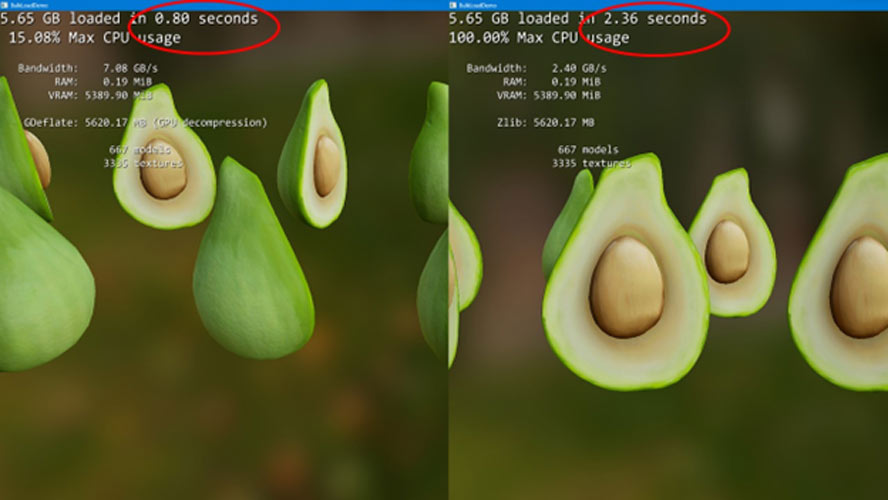DirectStorage 1.1 Can Speed Game Loading by 40% Claims Microsoft
Microsoft says the DirectStorage 1.1 API is coming soon to Windows PCs. With this release, Microsoft will enable GPU Decompression on PCs per its previously shared roadmap. The primary benefit of GPU Decompression is that PC gamers could see load times reduced by as much as 40% depending on the game and the PC hardware configuration.
DirectStorage 1.0 was introduced for Windows (10 and 11) in March 2022. It was designed to bring speed, bandwidth and latency optimizations to the Windows storage subsystem, which would scale with storage performance. Thus faster storage, like the latest NVMe SSDs, deliver greater overall benefits. Version 1.1 of the API builds on this promise with GPU Decompression, reducing the processing of graphical assets using the CPU and moving this workload to the GPU, which is adept at massively parallel processing and decompression tasks.
Microsoft explains in its DirectX Developer Blog that modern games typically require massive amounts of data to build and render the immersive worlds we navigate. This could mean hundreds of gigabytes of compressed data loaded to run the latest AAA titles. “When a game is run, the assets are transferred to system memory, where the CPU decompresses the data before it is finally copied into GPU memory to be used as needed,” says Senior Microsoft Program Manager, Cassie Hoef. “The transfer and decompression of these assets on gaming devices contributes heavily to load times and limits how much detail can be included in open world scenes.”
DirectStorage 1.1 has an optimized GPU-powered decompression algorithm to deliver loading performance benefits of up to 40% to the PC gaming experience. To back up its claims, Microsoft built an optimized demo where scene loading was up to 3x faster, and CPU loads were drastically reduced. Above, you can see a GPU with GDeflate (left) loading a scene in 0.8 seconds versus the CPU with Zlib (right) taking 2.36 seconds.
DirectStorage was initially described as a Windows 11-exclusive technology before Microsoft caved and facilitated its use in Windows 10 gaming experiences. Like the previous 1.0 version of the API, there are still said to be “additional optimizations in the IO stack available to Windows 11 users.” A DirectX 12-capable GPU supporting Shader Model 6.0 is necessary, and users should have game data on a high-speed NVMe SSD for optimal gains.
It will be interesting to see this technology applied in modern games, as in many titles on my mainstream 2022-built PC, it is the GPU that is usually maxed out, not the CPU.
Developers will be able to play with DirectStorage 1.1 later this year, and when it goes mainstream, we expect GPU driver updates from all major players. Please don’t hold your breath, though, as we are yet to see even one AAA game with DirectStorage 1.0 support released on Windows. Forspoken, by Square Enix, was going to spearhead DirectStorage on Windows this month but has been rescheduled for late January 2023.
Get Tom's Hardware's best news and in-depth reviews, straight to your inbox.

Mark Tyson is a news editor at Tom's Hardware. He enjoys covering the full breadth of PC tech; from business and semiconductor design to products approaching the edge of reason.
-
hotaru251 really wish they'd stop talking about it until its ACTUALLY used in more than 1 game. (where it had a minuscule improvement)Reply -
DavidLejdar Not sure GPU Decompression will do much for me, as I see not much a point in plopping e.g. a RTX 3060 alongside my current i5-4570 to begin with. But for many gamers, who upgrade the GPU more than anything else, there may be quite some boost there I suppose. See e.g. Steam hardware survey for September, according to which more than 40% have 4 physical cpus or less, while 22% have less than 4 GB VRAM.Reply
And such a boost would be good news for everyone, as game development seems tied up a bit to deliver a product that most gamers can actually play. And when the average technical capacity moves up, more what game development can work with.
Whether there is a NVMe SSD in these rigs, and at which time some developers make use of particularly GPU Decompression, a bit different matter of course. -
bentremblay Is the design thinking behind all this related somehow to our thinking when we pushed ArmA into a RAM disk?Reply -
FunSurfer Reply
It seems that DirectStorage will only boost systems sporting a fast PCIe 5.0 SSD or the fastest PCIe 4.0 SSD with the DirectStorage firmware (which are or will be super fast anyway) and not what most gamers have now :(DavidLejdar said:Not sure GPU Decompression will do much for me, as I see not much a point in plopping e.g. a RTX 3060 alongside my current i5-4570 to begin with. But for many gamers, who upgrade the GPU more than anything else, there may be quite some boost there I suppose. See e.g. Steam hardware survey for September, according to which more than 40% have 4 physical cpus or less, while 22% have less than 4 GB VRAM.
And such a boost would be good news for everyone, as game development seems tied up a bit to deliver a product that most gamers can actually play. And when the average technical capacity moves up, more what game development can work with.
Whether there is a NVMe SSD in these rigs, and at which time some developers make use of particularly GPU Decompression, a bit different matter of course. -
George³ It will always be much faster if compression/decompression is done through a dedicated chip like in PS5 . It may even be cheaper to acquire than through a non-specialized device, whether it is the CPU or the video card, which will spend some of its resources on such a non-specific activity.Reply -
little_me So.. this will help IFReply
Game will utilize all the cpu/gpu power that system has.
I do admit that I don't play most recent games but so far rare few if any of them even try to use all 6 cores/12 threads I have, so I have plenty of CPU resources to use for decompression.
another issue is disk speeds.. my poor Nvme can only do about 3000Mbit/sec loads/writes, no more, no less.
However, since windows is poor at disk managing, (speaking of 10 here, 11 might be lot better for some reason) windows tries to re-read and re-write lot of already on disk data on disk and read already in memory data to memory AGAIN.
Cutting this useless use out will save up to 70% of disk usage, which can then again be used by the game.
So.. as shown by Microsoft, this could help games IF games use this.
Games could also fully utilize already existing hardware and be lot faster than they are now without this technology.
Also most games don't need to load 5.65GB of textures or such every second, if they do, it shows poor coding on developer side, showing yet again that while this is all nice... (and it doesn't tell what GPU was used for that decompression, said GPU might be out of normal person price range) it is a niche technology for now.
so.. theoretical gains, yes.. practical? that depends a lot on hardware and game developer.
in theory, my sata HDD also has 3000+Mbit read/write speeds, even in practical speed tests. It's a lie though due to background ramcaching I have but... tests don't see that, they see fast reads/writes. -
jp7189 Reply
AFAIK it's limited to the latest nvme drives and also requires specific firmware to enable.WrongRookie said:I hope it's not just restricted to NVME drives. Rather all from Sata till gen 3.
Complexities with protocol abstraction make it unlikely sata3 will ever get support for this. -
WrongRookie Replyjp7189 said:AFAIK it's limited to the latest nvme drives and also requires specific firmware to enable.
Complexities with protocol abstraction make it unlikely sata3 will ever get support for this.
Pretty sure one game showed speed comparisons for them all.
Ifux49qqGhcView: https://www.youtube.com/watch?v=Ifux49qqGhc
